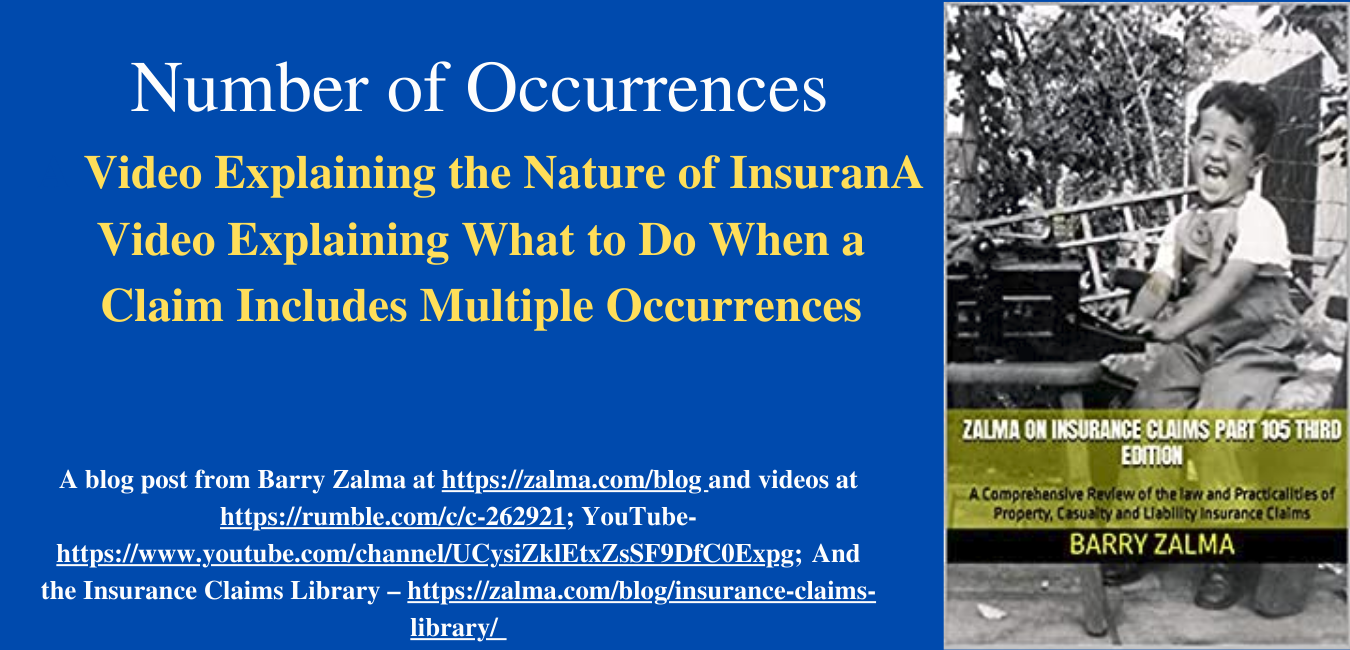Number of Occurrences

A Video Explaining What to Do When a Claim Includes Multiple Occurrences
Read the full article at https://www.linkedin.com/pulse/number-occurrences-barry-zalma-esq-cfe and see the full video at https://youtu.be/S-gMSLPyp3k and at https://rumble.com/vnllfy-a-video-explaining-what-to-do-when-a-claim-includes-multiple-occurrences.html and at https://zalma.com/blog plus more than 3900 posts.
CGL policies are written with endorsements that make the number of occurrences highly important, especially in continuing loss cases. deductibles or self-insured retentions are charged based on the number of occurrences or the number of claims. policy limits can apply individually per occurrence, individually per loss, individually per claim, or in the aggregate over a one year period. The test applied is usually objective. [Uniroyal, Inc. v. Home Insurance Company, 707 F. Supp. 1368 (1988); Champion International Corporation v. Continental Casualty Company, 546 F. 2d 502 (1976), Cargill, Inc. v. Liberty Mutual Insurance Company, 488 F. Supp. 49 (1979) Affirmed 621 F. 2d 275 (1980); Mason v. Home Insurance Company, 177 Ill. App. 3d 454, 532 N.E. 2d 526 (1988); 64 A.L.R. 4th 688.]
A triggering injury in fact for an underlying claim may be found as early as the time of first exposure to asbestos or silica, and may continue progressively through the claimant’s death or the date of filing the claim, whichever occurs earlier. [Danaher Corp. v. Travelers Indem. Co., 414 F.Supp.3d 436 (S.D. N.Y. 2019)]
In Lombard v. Sewerage and Water Board of New Orleans, 284 So.2d 905 (La.1973) and its progeny, the courts in exposure cases have applied the “effect” test as opposed to the “cause” test in determining the number of [Thebault V. American Home, 2015-0800 (La. App. 4Cir. 4/20/16), 195 So. 3d 113.]
A common method of allocation is referred to as the “time on the risk” method, whereby each insurer is responsible for the pro rata percentage of time the insurer’s policy was in effect over the course of the full time period over which loss was sustained by the insured. For example, Edison Co. Of New York, Inc. v. Allstate Ins. Co., 774 N.E.2d 687, 695 (N.Y. 2002)] affirmed the trial court allocation of loss through “time-on-the-risk” method, while “not foreclos[ing] pro rata allocation among insurers by other methods.”
We are 100% funded for October.
Thanks to everyone who helped out. 🥰
Xephula monthly operating expenses for 2024 - Server: $143/month - Backup Software: $6/month - Object Storage: $6/month - SMTP Service: $10/month - Stripe Processing Fees: ~$10/month - Total: $175/month
- Art
- Causes
- Crafts
- Crime
- Dance
- Drinks
- Film
- Finance
- Fitness
- Food
- Игры
- Gardening
- Health
- Главная
- Literature
- Music
- Networking
- Paranormal
- Другое
- Politics
- Истории
- News
- Party
- Science
- Religion
- Shopping
- Sports
- SyFy
- Politically Incorrect
- Philosophy
- Theater
- Technology
- Wellness



